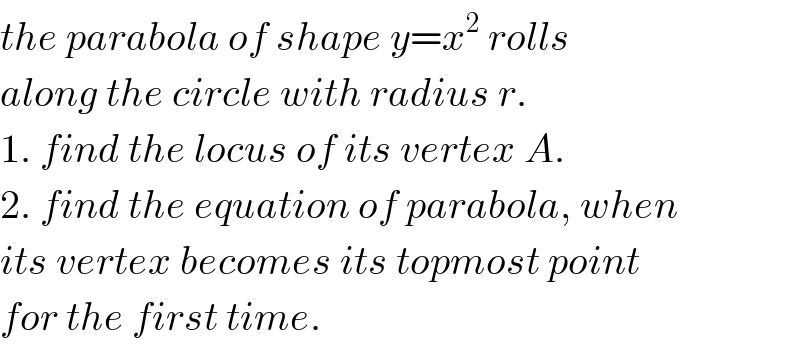Question Number 125709 by mr W last updated on 13/Dec/20

Commented by mr W last updated on 13/Dec/20

$${the}\:{parabola}\:{of}\:{shape}\:{y}={x}^{\mathrm{2}} \:{rolls} \\ $$$${along}\:{the}\:{circle}\:{with}\:{radius}\:{r}.\: \\ $$$$\mathrm{1}.\:{find}\:{the}\:{locus}\:{of}\:{its}\:{vertex}\:{A}. \\ $$$$\mathrm{2}.\:{find}\:{the}\:{equation}\:{of}\:{parabola},\:{when} \\ $$$${its}\:{vertex}\:{becomes}\:{its}\:{topmost}\:{point} \\ $$$${for}\:{the}\:{first}\:{time}. \\ $$
Answered by ajfour last updated on 13/Dec/20

Commented by ajfour last updated on 13/Dec/20

$${Contact}\:{point}\:{T}\left({p},\:{p}^{\mathrm{2}} \right) \\ $$$$\left({with}\:{vertex}\:{of}\:{parabola}\:{as}\:{origin}\right) \\ $$$$\mathrm{tan}\:\phi=\mathrm{2}{p} \\ $$$${s}={r}\theta=\int_{\mathrm{0}} ^{\:{p}} \sqrt{\mathrm{1}+\mathrm{4}{p}^{\mathrm{2}} }{dp} \\ $$$$\:=\frac{\mathrm{1}}{\mathrm{4}}\left\{\mathrm{2}{p}\sqrt{\mathrm{1}+\mathrm{4}{p}^{\mathrm{2}} }+\mathrm{ln}\:\left(\mathrm{2}{p}+\sqrt{\mathrm{1}+\mathrm{4}{p}^{\mathrm{2}} }\right)\right\} \\ $$$$\Rightarrow\:\mathrm{4}{r}\theta=\mathrm{sec}\:\phi\mathrm{tan}\:\phi \\ $$$$\:\:\:\:\:\:\:\:\:\:\:\:\:\:\:\:\:\:+\mathrm{ln}\:\left(\mathrm{tan}\:\phi+\mathrm{sec}\:\phi\right) \\ $$$${O}\left({p}+{r}\mathrm{sin}\:\phi,\:{p}^{\mathrm{2}} −{r}\mathrm{cos}\:\phi\right)\equiv\left({h},{k}\right) \\ $$$$\delta=\theta+\phi−\frac{\pi}{\mathrm{2}} \\ $$$${eq}.\:{of}\:{y}\:{axis}\:{in}\:{pq}\:{or}\:{XY}\:{coordinate} \\ $$$${Y}−\left({p}^{\mathrm{2}} −{r}\mathrm{cos}\:\phi\right) \\ $$$$\:\:=\mathrm{tan}\:\delta\left\{{X}−\left({p}+{r}\mathrm{sin}\:\phi\right)\right\} \\ $$$${Y}\:{intercept}\:\:\left({X}=\mathrm{0}\right) \\ $$$${Y}={p}^{\mathrm{2}} −{r}\mathrm{cos}\:\phi−\left({p}+{r}\mathrm{sin}\:\phi\right)\mathrm{tan}\:\delta \\ $$$${x}=−{Y}\mathrm{cos}\:\delta \\ $$$${x}=\left({p}+{r}\mathrm{sin}\:\phi\right)\mathrm{sin}\:\delta \\ $$$$\:\:\:\:\:\:\:−\left({p}^{\mathrm{2}} −{r}\mathrm{cos}\:\phi\right)\mathrm{cos}\:\delta \\ $$$${y}=\frac{{k}}{\mathrm{sin}\:\delta}+\frac{{x}}{\mathrm{tan}\:\delta} \\ $$$${y}=\left(\frac{{p}^{\mathrm{2}} −{r}\mathrm{cos}\:\phi}{\mathrm{sin}\:\delta}\right)+\left({p}+{r}\mathrm{sin}\:\phi\right)\mathrm{cos}\:\delta \\ $$$$\:\:\:\:\:\:\:\:\:−\left(\frac{{p}^{\mathrm{2}} −{r}\mathrm{cos}\:\phi}{\mathrm{sin}\:\delta}\right)\mathrm{cos}\:^{\mathrm{2}} \delta \\ $$$$\:\:\_\_\_\_\_\_\_\_\_\_\_\_\_\_\_\_\_\_\_\_\_\_\_\_\_ \\ $$$${y}=\left({p}+{r}\mathrm{sin}\:\phi\right)\mathrm{cos}\:\delta+\left({p}^{\mathrm{2}} −{r}\mathrm{cos}\:\phi\right)\mathrm{sin}\:\delta \\ $$$${x}=\left({p}+{r}\mathrm{sin}\:\phi\right)\mathrm{sin}\:\delta−\left({p}^{\mathrm{2}} −{r}\mathrm{cos}\:\phi\right)\mathrm{cos}\:\delta \\ $$$$\mathrm{2}{p}=\mathrm{tan}\:\phi \\ $$$$\delta=\theta+\phi−\frac{\pi}{\mathrm{2}} \\ $$$$\mathrm{4}{r}\theta=\mathrm{sec}\:\phi\mathrm{tan}\:\phi+\mathrm{ln}\:\left(\mathrm{tan}\:\phi+\mathrm{sec}\:\phi\right) \\ $$$$\:\:\_\_\_\_\_\_\_\_\_\_\_\_\_\_\_\_\_\_\_\_\_\_\_\_\_ \\ $$$${when}\:{vetex}\:{of}\:{parabola}\:{becomes} \\ $$$${topmost}\:{point}\:{the}\:{first}\:{time}\:{in} \\ $$$${xy}\:{plane}\:{then}\:\:\theta+\phi=\pi \\ $$$$\Rightarrow\:\:\delta=\frac{\pi}{\mathrm{2}} \\ $$$${y}={p}^{\mathrm{2}} −{r}\mathrm{cos}\:\phi \\ $$$${x}={p}+{r}\mathrm{sin}\:\phi \\ $$$$\mathrm{2}{p}=\mathrm{tan}\:\phi \\ $$
Commented by mr W last updated on 13/Dec/20

$${perfect}!\:{your}\:{approach}\:{is}\:{very}\:{smart}. \\ $$
Commented by ajfour last updated on 13/Dec/20
i shall have to edit, sir. I tried plotting,
it dint come out correct on grapher...
Commented by mr W last updated on 13/Dec/20

$${i}\:{found}\:{all}\:{correct}\:{sir}.\:{locus}\:{is}\:{correct}. \\ $$$${from}\:\delta=\frac{\pi}{\mathrm{2}}\:{we}\:{get}\:{p}=\mathrm{1}.\mathrm{7555}. \\ $$
Commented by mr W last updated on 13/Dec/20

Answered by mr W last updated on 13/Dec/20

Commented by mr W last updated on 13/Dec/20
![P(t,t^2 ) in x′y′−system AP_(Parabola) =(1/4)[ln (2t+(√(1+4t^2 )))+2t(√(1+4t^2 ))] AP_(Circle) =rϕ ⇒ϕ=(1/(4r))[ln (2t+(√(1+4t^2 )))+2t(√(1+4t^2 ))] tan θ=2t sin θ=((2t)/( (√(1+4t^2 )))) cos θ=(1/( (√(1+4t^2 )))) P(r sin ϕ, r cos ϕ) in xy−system φ=θ+ϕ−(π/2) x_A =r sin ϕ+t sin φ−(t^2 −f)cos φ =r sin ϕ−t cos (θ+ϕ) −(t^2 −f)sin (θ+ϕ) =r sin ϕ−t cos θ cos ϕ+t sin θ sin ϕ −(t^2 −f)sin θ cos ϕ−(t^2 −f)cos θ sin ϕ =r sin ϕ−cos θ [(t^2 −f) sin ϕ+t cos ϕ]+sin θ[t sin ϕ −(t^2 −f)cos ϕ] =r sin ϕ−(1/( (√(1+4t^2 )))) [(t^2 −f) sin ϕ+t cos ϕ]+((2t)/( (√(1+4t^2 ))))[t sin ϕ −(t^2 −f)cos ϕ] y_A =r cos ϕ+t cos φ+(t^2 −f)sin φ =r cos ϕ+t sin (θ+ϕ)−(t^2 −f)cos (θ+ϕ) =r cos ϕ+t sin θ cos ϕ+t cos θ sin ϕ−(t^2 −f)cos θ cos ϕ+(t^2 −f)sin θ sin ϕ =r cos ϕ+ cos θ[t sin ϕ−(t^2 −f) cos ϕ]+sin θ[(t^2 −f)sin ϕ+t cos ϕ] =r cos ϕ+ (1/( (√(1+4t^2 ))))[t sin ϕ−(t^2 −f) cos ϕ]+((2t)/( (√(1+4t^2 ))))[(t^2 −f)sin ϕ+t cos ϕ] A: { ((x=r sin ϕ−(1/( (√(1+4t^2 )))) [(t^2 −f) sin ϕ+t cos ϕ]+((2t)/( (√(1+4t^2 ))))[t sin ϕ −(t^2 −f)cos ϕ])),((y=r cos ϕ+ (1/( (√(1+4t^2 ))))[t sin ϕ−(t^2 −f) cos ϕ]+((2t)/( (√(1+4t^2 ))))[(t^2 −f)sin ϕ+t cos ϕ])) :} (offset f is introduced here to treat a different point other than the vertex) when A is topmost in xy−system: φ=(π/2) θ+ϕ=π tan^(−1) (2t)+(1/(4r))[ln (2t+(√(1+4t^2 )))+2t(√(1+4t^2 ))]=π ⇒t≈1.7556](https://www.tinkutara.com/question/Q125755.png)
$${P}\left({t},{t}^{\mathrm{2}} \right)\:{in}\:{x}'{y}'−{system} \\ $$$${AP}_{{Parabola}} =\frac{\mathrm{1}}{\mathrm{4}}\left[\mathrm{ln}\:\left(\mathrm{2}{t}+\sqrt{\mathrm{1}+\mathrm{4}{t}^{\mathrm{2}} }\right)+\mathrm{2}{t}\sqrt{\mathrm{1}+\mathrm{4}{t}^{\mathrm{2}} }\right] \\ $$$${AP}_{{Circle}} ={r}\varphi \\ $$$$\Rightarrow\varphi=\frac{\mathrm{1}}{\mathrm{4}{r}}\left[\mathrm{ln}\:\left(\mathrm{2}{t}+\sqrt{\mathrm{1}+\mathrm{4}{t}^{\mathrm{2}} }\right)+\mathrm{2}{t}\sqrt{\mathrm{1}+\mathrm{4}{t}^{\mathrm{2}} }\right] \\ $$$$\mathrm{tan}\:\theta=\mathrm{2}{t} \\ $$$$\mathrm{sin}\:\theta=\frac{\mathrm{2}{t}}{\:\sqrt{\mathrm{1}+\mathrm{4}{t}^{\mathrm{2}} }} \\ $$$$\mathrm{cos}\:\theta=\frac{\mathrm{1}}{\:\sqrt{\mathrm{1}+\mathrm{4}{t}^{\mathrm{2}} }} \\ $$$$ \\ $$$${P}\left({r}\:\mathrm{sin}\:\varphi,\:{r}\:\mathrm{cos}\:\varphi\right)\:{in}\:{xy}−{system} \\ $$$$\phi=\theta+\varphi−\frac{\pi}{\mathrm{2}} \\ $$$${x}_{{A}} ={r}\:\mathrm{sin}\:\varphi+{t}\:\mathrm{sin}\:\phi−\left({t}^{\mathrm{2}} −{f}\right)\mathrm{cos}\:\phi \\ $$$$={r}\:\mathrm{sin}\:\varphi−{t}\:\mathrm{cos}\:\left(\theta+\varphi\right)\:−\left({t}^{\mathrm{2}} −{f}\right)\mathrm{sin}\:\left(\theta+\varphi\right) \\ $$$$={r}\:\mathrm{sin}\:\varphi−{t}\:\mathrm{cos}\:\theta\:\mathrm{cos}\:\varphi+{t}\:\mathrm{sin}\:\theta\:\mathrm{sin}\:\varphi\:−\left({t}^{\mathrm{2}} −{f}\right)\mathrm{sin}\:\theta\:\mathrm{cos}\:\varphi−\left({t}^{\mathrm{2}} −{f}\right)\mathrm{cos}\:\theta\:\mathrm{sin}\:\varphi \\ $$$$={r}\:\mathrm{sin}\:\varphi−\mathrm{cos}\:\theta\:\left[\left({t}^{\mathrm{2}} −{f}\right)\:\mathrm{sin}\:\varphi+{t}\:\mathrm{cos}\:\varphi\right]+\mathrm{sin}\:\theta\left[{t}\:\mathrm{sin}\:\varphi\:−\left({t}^{\mathrm{2}} −{f}\right)\mathrm{cos}\:\varphi\right] \\ $$$$={r}\:\mathrm{sin}\:\varphi−\frac{\mathrm{1}}{\:\sqrt{\mathrm{1}+\mathrm{4}{t}^{\mathrm{2}} }}\:\left[\left({t}^{\mathrm{2}} −{f}\right)\:\mathrm{sin}\:\varphi+{t}\:\mathrm{cos}\:\varphi\right]+\frac{\mathrm{2}{t}}{\:\sqrt{\mathrm{1}+\mathrm{4}{t}^{\mathrm{2}} }}\left[{t}\:\mathrm{sin}\:\varphi\:−\left({t}^{\mathrm{2}} −{f}\right)\mathrm{cos}\:\varphi\right] \\ $$$$ \\ $$$${y}_{{A}} ={r}\:\mathrm{cos}\:\varphi+{t}\:\mathrm{cos}\:\phi+\left({t}^{\mathrm{2}} −{f}\right)\mathrm{sin}\:\phi \\ $$$$={r}\:\mathrm{cos}\:\varphi+{t}\:\mathrm{sin}\:\left(\theta+\varphi\right)−\left({t}^{\mathrm{2}} −{f}\right)\mathrm{cos}\:\left(\theta+\varphi\right) \\ $$$$={r}\:\mathrm{cos}\:\varphi+{t}\:\mathrm{sin}\:\theta\:\mathrm{cos}\:\varphi+{t}\:\mathrm{cos}\:\theta\:\mathrm{sin}\:\varphi−\left({t}^{\mathrm{2}} −{f}\right)\mathrm{cos}\:\theta\:\mathrm{cos}\:\varphi+\left({t}^{\mathrm{2}} −{f}\right)\mathrm{sin}\:\theta\:\mathrm{sin}\:\varphi \\ $$$$={r}\:\mathrm{cos}\:\varphi+\:\mathrm{cos}\:\theta\left[{t}\:\mathrm{sin}\:\varphi−\left({t}^{\mathrm{2}} −{f}\right)\:\mathrm{cos}\:\varphi\right]+\mathrm{sin}\:\theta\left[\left({t}^{\mathrm{2}} −{f}\right)\mathrm{sin}\:\varphi+{t}\:\mathrm{cos}\:\varphi\right] \\ $$$$={r}\:\mathrm{cos}\:\varphi+\:\frac{\mathrm{1}}{\:\sqrt{\mathrm{1}+\mathrm{4}{t}^{\mathrm{2}} }}\left[{t}\:\mathrm{sin}\:\varphi−\left({t}^{\mathrm{2}} −{f}\right)\:\mathrm{cos}\:\varphi\right]+\frac{\mathrm{2}{t}}{\:\sqrt{\mathrm{1}+\mathrm{4}{t}^{\mathrm{2}} }}\left[\left({t}^{\mathrm{2}} −{f}\right)\mathrm{sin}\:\varphi+{t}\:\mathrm{cos}\:\varphi\right] \\ $$$${A}:\begin{cases}{{x}={r}\:\mathrm{sin}\:\varphi−\frac{\mathrm{1}}{\:\sqrt{\mathrm{1}+\mathrm{4}{t}^{\mathrm{2}} }}\:\left[\left({t}^{\mathrm{2}} −{f}\right)\:\mathrm{sin}\:\varphi+{t}\:\mathrm{cos}\:\varphi\right]+\frac{\mathrm{2}{t}}{\:\sqrt{\mathrm{1}+\mathrm{4}{t}^{\mathrm{2}} }}\left[{t}\:\mathrm{sin}\:\varphi\:−\left({t}^{\mathrm{2}} −{f}\right)\mathrm{cos}\:\varphi\right]}\\{{y}={r}\:\mathrm{cos}\:\varphi+\:\frac{\mathrm{1}}{\:\sqrt{\mathrm{1}+\mathrm{4}{t}^{\mathrm{2}} }}\left[{t}\:\mathrm{sin}\:\varphi−\left({t}^{\mathrm{2}} −{f}\right)\:\mathrm{cos}\:\varphi\right]+\frac{\mathrm{2}{t}}{\:\sqrt{\mathrm{1}+\mathrm{4}{t}^{\mathrm{2}} }}\left[\left({t}^{\mathrm{2}} −{f}\right)\mathrm{sin}\:\varphi+{t}\:\mathrm{cos}\:\varphi\right]}\end{cases} \\ $$$$\left({offset}\:{f}\:{is}\:{introduced}\:{here}\:{to}\:{treat}\:{a}\right. \\ $$$$\left.{different}\:{point}\:{other}\:{than}\:{the}\:{vertex}\right) \\ $$$$ \\ $$$${when}\:{A}\:{is}\:{topmost}\:{in}\:{xy}−{system}: \\ $$$$\phi=\frac{\pi}{\mathrm{2}} \\ $$$$\theta+\varphi=\pi \\ $$$$\mathrm{tan}^{−\mathrm{1}} \left(\mathrm{2}{t}\right)+\frac{\mathrm{1}}{\mathrm{4}{r}}\left[\mathrm{ln}\:\left(\mathrm{2}{t}+\sqrt{\mathrm{1}+\mathrm{4}{t}^{\mathrm{2}} }\right)+\mathrm{2}{t}\sqrt{\mathrm{1}+\mathrm{4}{t}^{\mathrm{2}} }\right]=\pi \\ $$$$\Rightarrow{t}\approx\mathrm{1}.\mathrm{7556} \\ $$
Commented by mr W last updated on 13/Dec/20

Commented by ajfour last updated on 13/Dec/20

$${Sir},\:{can}\:{you}\:{try}\:{and}\:{help}\:{plotting} \\ $$$${my}\:{graph}\:{for}\:{the}\:{second}\:{part}\:{of} \\ $$$${the}\:{question}?\:{i}\:{dont}\:{get}\:{it}\:{correct}, \\ $$$${neither}\:{can}\:{find}\:{mistake}\:{in}\:{my} \\ $$$${solution}.. \\ $$
Commented by mr W last updated on 13/Dec/20

$${i}\:{found}\:{no}\:{mistake}\:{in}\:{your}\:{solution}. \\ $$$${all}\:{is}\:{correct}. \\ $$
Commented by ajfour last updated on 13/Dec/20

$${Thanks}\:{enormously}\:{Sir},\:{I}\:{just} \\ $$$${then}\:{need}\:{to}\:{learn}\:{plotting} \\ $$$${on}\:{grapher}\:{the}\:{parametric}\:{way}! \\ $$
Commented by mr W last updated on 15/Dec/20

$${great}\:{to}\:{see}\:{you}\:{again}\:{too}! \\ $$
Commented by Tinkutara last updated on 15/Dec/20
Great to see you both mrW and ajfour Sirs active still!
Commented by ajfour last updated on 15/Dec/20

$${how}\:{well}\:{are}\:{you}\:{doing}\:{at}\:{college}, \\ $$$${engineering}\:{mathematics}? \\ $$
Commented by Tinkutara last updated on 16/Dec/20
I am doing Civil Engg from prestigious IIT.! Thanks for your support Sir!
